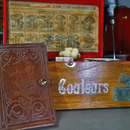Introduction: Jet Propelled Radio Controlled Duck
40+ years ago I wanted to get a radio control boat and use it on the nearby Park Lake, however the Park Keeper made it quite clear that no boats would be allowed. So I hatched this plan to disguise a boat as a duck. Slight drawback was the price of radio controls and boats, the only one I remember was a Swan Macgregor Digimac 1 channel radio, which probably cost a years pocket money. At some point about 25 years ago I did buy some plastic ducks, but nothhing ever came about, so fast forward to today, and I thought it was about time I realised that dream and make a radio control duck.
Aware of the amount of weeds and flotsam I also decided that instead of a propeller and rudder, I would use one of the cheap 15mm Jet Drives that can be bought really cheap.
Step 1: 3D Printed Hull and Electronics Bay
First step was to design and print a hull and place the jet unit into that. I wasnt able to find any dimensioned drawings of the units, so painstakingly had to measure and make plenty of test prints until I had something that worked. I knew that I would also need a lot of silicon sealant to make it waterproof, but the dimensions turned out to be pretty correct. I also printed up a smaller box that would sit inside the hull to contain the electronics and provide a secondary barrier to the water in case there were any leaks as well as to keep things tidy. I printed the hull and box in ABS, but pretty much anything would do the trick.
Step 2: Test Fit
So here are some of the many test fits to see how everything goes together. I also needed to print a small sled to hold the servo that would pivot the nozzle for direction control. These units also come with a water cooling jacket, but I've decided not to use this as I'm only running this at very light throttle settings. The other thing to line up is the servo control rod as it has to pass through the hull.
Step 3: Cut the Duck
This was a fairly easy operation as I had already designed the hull to fit within the duck. The hull was designed with a lip and so I just placed the hull on the duck and traced the edges. A scalpel was all that was needed to cut through the decoy body and the hull was pressed into place. Silicon sealant would eventually glue the two parts together.
Step 4: Battery Case and Wiring
I'm using a pretty standard remote control set up here with a 2s LIPO battery and an Orange RX in conjunction with a DX6i transmitter
The servo is just a cheap 9g servo and some brass rod for the push rod to act as the rudder. For a speed controller I had plenty of these simple 10A ESC controllers with a built in battery eliminator. Just to keep things safe, I'm also using a LiPo alarm unit which gives off a really nice loud beep when the battery gets low so you know to come back in to the shore.
Step 5: Sealing the Hull With Silcone Sealant
With the hull fitted up, I used some automotive black silicone sealant on every edge. I actually went over it twice as well to stop any leaks, and it also bonds the hull to the body of the duck.
Step 6: Bellows on Direction/rudder
The rudder arm has to protude through the hull so I am using some Bellows that are packed with grease to keep them sealed, and a cable tie on the end to help keep it watertight.
The transmitter throw had to be adjusted as well as the nozzle on the jet motors dont have a lot of travel and I ended up with only about 45% of the normal travel.
Step 7: Cutting the Lid
To be able to remove the battery I cut out a hatch on the top and added some tabs with plasticard, glued these solibond which is some pretty amazing glue to use. I then added a little magnet at the back as well to keep the lid shut and another magnet under the plastic tab
Not exactly waterproof, but it should stop splashing and its a low speed duck dont forget, so minimal wash
Step 8: DUCK BOM - Parts List
1. A Duck - plastic decoy (not wood)- https://ebay.to/3izbcki
2. 15mm Jet boat motor - https://ebay.to/2Ruri2U
3. TX/RX - Futaba DX6i + Lemon DSMX RX - https://ebay.to/3c0eZ7K
4. 10A Esc - https://ebay.to/3mnfltZ
5. 9g Servo - https://ebay.to/2ZEMYha
6. 2s Lipo (JST connector to fit ESC) - https://ebay.to/3c1LO49
7. LIPO Alarm - https://ebay.to/3ixalkc
8. Bellows - https://ebay.to/2FCd4dp
9. Brass rod , bent 1.6mm
10. Plasticard for lid
11. Solibond glue (500ml size) - https://bit.ly/3hyLuv5
12. ABS/PETG Hull - STL (hull outline based on a design by Darren Gossling)
13. ABS/PETG Servo mount
14. ABS/PETG Battery sled
15. ABS/PETG RX case
16. Black Silicon sealant - https://ebay.to/2FwRzen
Step 9: Bath Time
It works, it runs and has a turn of speed. There is no real reverse to speak of, but it will slowly go backwards. If you wanted real reverse then you'd need nozzle blades to divert the flow
Step 10: Down at the River
What a beautiful site as the duck glides around the lake. Take THAT Park Keeper !

Runner Up in the
Make it Move Contest 2020
















